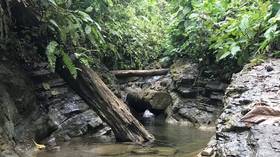‘Wind’ from ‘middle Earth’ found in hidden passage

Scientists have uncovered a secret passage beneath Panama through which “wind” from the Earth’s mantle layer is “blowing.” The discovery could explain why the nation has few active volcanoes despite being in a geological hotspot.
The opening, located about 100km (62 miles) below central Panama, might serve as a conduit for mantle rocks and materials to travel more than 1,600km (1,000 miles) from their point of origin underneath the Galapagos Islands, according to research published last month in the Proceedings of the National Academy of Sciences journal.
The window-like passage is located on the Cocos tectonic plate, which is responsible for creating a line of volcanoes called the Central American Volcanic Arc by pushing oceanic crust underneath the North American, Caribbean, and Panama tectonic plates. This process, called subduction, is responsible for lava flowing to the surface and powerful earthquakes.
However, the volcanism stops in western Panama, said the study’s lead author, David Bekaert, from the Woods Hole Oceanographic Institution (WHOI) in Massachusetts. The researchers were studying subduction dynamics by collecting rock and fluid samples in the region when they found “exotic [geochemical] signatures” resembling those found in the Galapagos.
We can compare volcanic systems to the body of a living organism; when the organism bleeds, it’s kind of like magma bleeding out of the Earth. And you can measure the composition of that magma, just like you can measure a blood type.
The team “measured an unexpected volcanic gas composition, sort of like when a human has a rare blood type,” Bekaert added.
Using seismic imaging and modeling to map the area, Bekaert told Live Science that the team found a “hole, a window through the [tectonic] slab” that lets mantle material pass through. WHOI scientist Peter Barry compared this lateral flow of material from deep in the Earth to a “mantle wind blowing through the window in the subduction zone.”
This “slab window” under Panama makes it harder to trap water – needed to create flowing magma and promote volcano formation – in the area, Bekaert said, which could be one explanation for the lack of active volcanoes.











